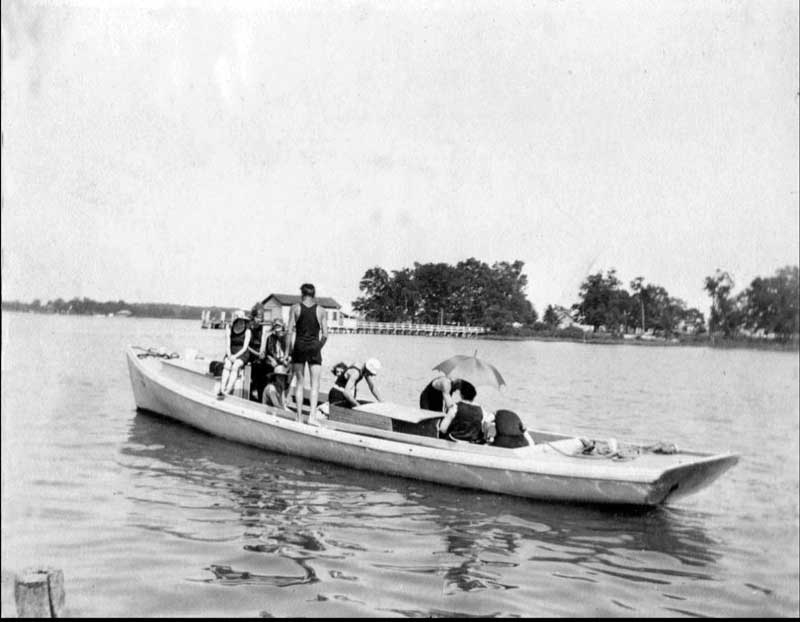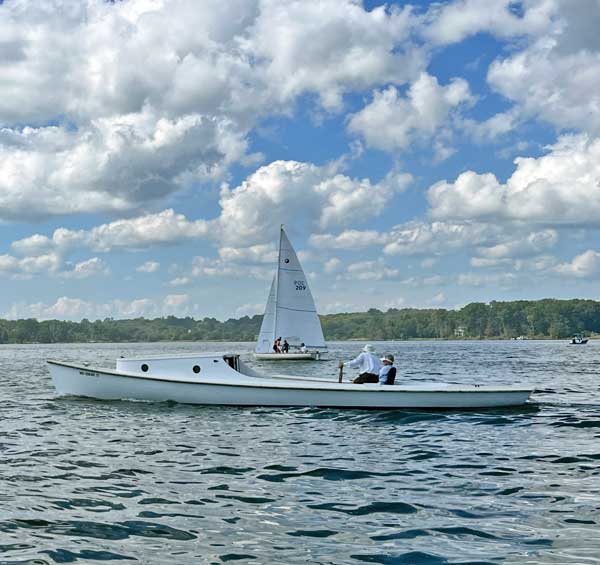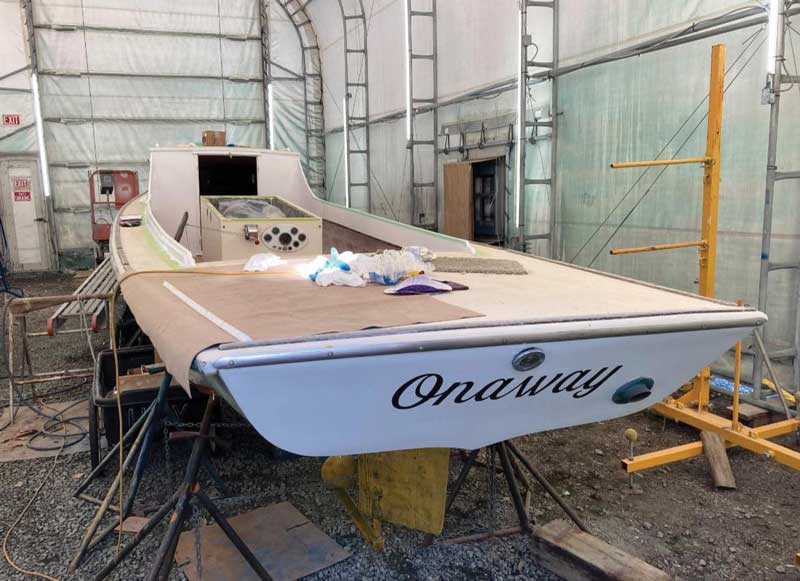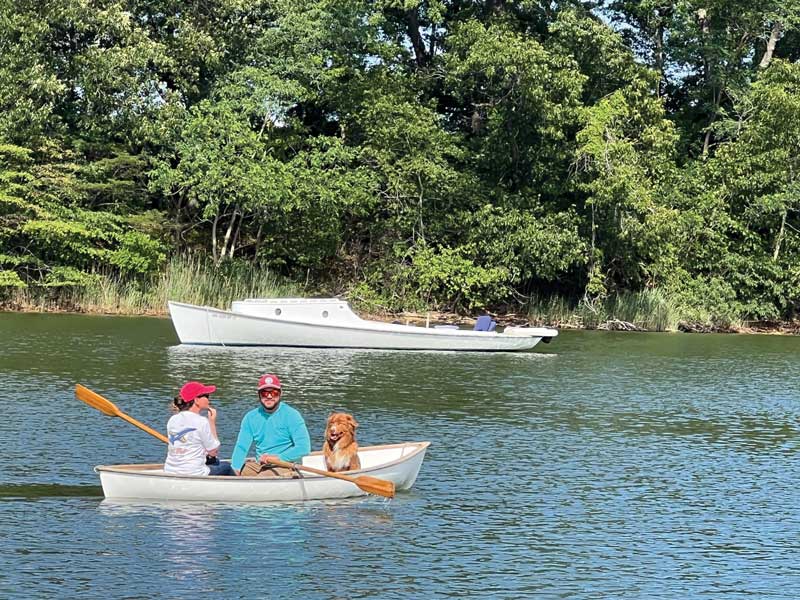Is that a sailboat without a mast? Nope! And it’s not a true deadrise either; Onaway is in a field of her own. We recently reached out to Xan Schlegel, the service manager at Hartge Yacht Yard, after he submitted a photo of his dog Dodger for PropTalk’s cover contest. Dodger was aboard a beautiful classic boat, so we had to learn more. Xan and his father Alex Schlegel (his full name is Emile Alexander Schlegel after the yard’s founder), the owner and general manager of Hartge Yacht Yard, shared more about Onaway’s history.

Onaway was built around 1920/1921 by Xan’s great great uncle, Captain Dick Hartge. He was 26 years old at the time, and while he built the boat, it was designed by his father, Emile Alexander Hartge, who started Hartge Yacht Yard in 1865.
Captain Dick’s main claim to fame, however, are the Chesapeake 20 sailboats. He designed and built them, and they are still an active one-design class today. Xan estimates that he also probably built another 150 or so vessels in addition to those over the years.
But back to Onaway—she’s 36 feet long and about eight feet wide, making her long, low, and narrow, and she has a round bottom as opposed to a traditional hard chine deadrise. Xan says, “I’ve heard them called ‘river boats’ before; they look like a deadrise in terms of the sheer line. They are lower to the water and were built for commuting or working in calmer waters.

“It was pretty much the kind of boat that was designed around that timeframe,” adds Alex. “They had small horsepower engines (typically one to two cylinder) and were easily driven. Pretty much all the workboats of that time were long and low and narrow. This boat was designed as more of a pleasure boat; something to ride around the river on. Back in those days water was still the main means of transportation.”
When I asked about the typical upkeep and maintenance required for Onaway, Xan and Alex explained how the boat was ‘glassed over’ with fiberglass in the 80s, so it doesn’t require as much work as the typical workboat or a typical wood boat.
Similarly, all of the wooden Chesapeake 20s were also eventually glassed over (not when they were built, but probably sometime during the 60s). Alex says, “Most wooden boats were not covered in glass at the time; it wasn’t worth the trouble, I guess. It was easier to maintain a wooden boat (labor and materials were cheaper), but later, as prices changed, it became easier to maintain a fiberglass boat.
“Folk wisdom used to say that covering a wood boat with fiberglass would cause a boat to rot, but if it’s done properly and is maintained properly, that hasn’t been my experience,” he added.

The cabin was originally low and squared off. Later the cabin was rebuilt using a single piece of steam-bent oak as the cabin wound around with additional planks added above to raise the cabin top. The interior of the cabin is varnished, and the outside is painted. The seam between the single panel of steam-bent oak and the upper planks opens as the seasons change, which requires a little filling and painting every year.
Apart from that, the bottom paint is done every year, and they work to keep the hull sides looking nice. There’s also of course typical yearly engine maintenance. Onaway has a Chrysler Slant-Six, about 145-hp. Alex says in general it’s a pretty low maintenance vessel since it’s been glassed over and had a major refit in the 80s (which included a new deck, all new frames and timbers, engine beds, and a new engine).
“I don’t know who the boat was built for, or who owned it, the builder or his father, but it was used as transportation, not as a watermen’s boat,” says Alex. “All the pictures I’ve seen of it are just people having fun, swimming off of it, just riding around. At one point it was sold to the Labrot family; they owned and eventually sold the land that became Sandy Point State Park.”
Alex’s father and uncle bought the boat back, sometime during the 1950s, so there was only a short time when it wasn’t in the family. When his father passed away in the late 60s, Alex maintained Onaway after that, and his mother officially gave him the boat sometime around 1970.
So, how does Onaway fare out on the Bay? Xan says he typically takes the boat out about half a dozen times during the year, sometimes more, and has been to Annapolis quite a few times. Recently Xan, his girlfriend Madde, and their dog Dodger did a circumnavigation of Wye Island, cruising nicely at around eight to nine knots.

“It’s definitely a crowd pleaser,” says Xan. “Everyone always asks who built the boat and people ask, ‘Is that a sailboat without a mast in it?’
“One time we brought it up to Annapolis where these guys were sitting on their boat in Ego Alley,and they had three scoreboards that said ‘style,’ ‘class,’ and ‘party’ and we got 10, 10, 10,” he says.
Regarding the boat’s name, Alex says it’s “always been Onaway,” but they have never known where the name came from.
“There’s a town in Michigan named Onaway, but I don’t think that’s where it came from,” he says. “Everyone who would know about the name died long ago.”
Xan joked that it could be a simple as a South County accent shouting “we’re on the way!”
So, if you’re out on the Bay and happen to see a long and low boat that kind of looks like a deadrise but also kind of looks like a sailboat missing a mast, chances are it might just be Onaway. Be sure to give them a wave!
By Kaylie Jasinski